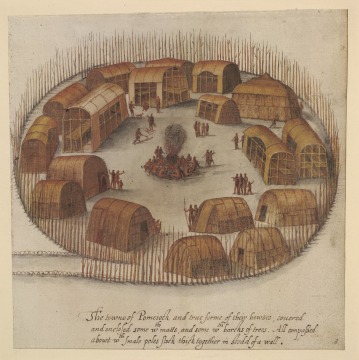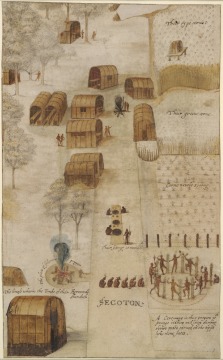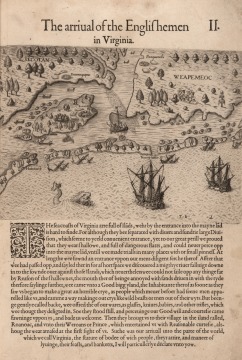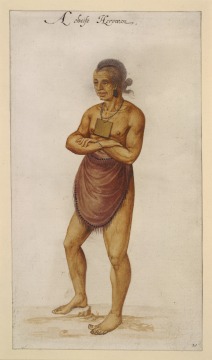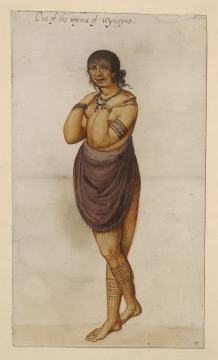AD 1585: English scouts infect Lumbee on Roanoke Island
Sir Walter Raleigh sponsors colonists who try establish the first English settlement in Virginia. An English reconnaissance party on Roanoke Island (in present-day North Carolina) spreads an unknown pathogen that kills Lumbee people on Roanoke and Croatan Islands and the mainland.
- Theme
- Epidemics
- Region
- Southeast
“Indian village of Pomeiooc,” watercolor drawing by John White, created between 1585–1586. White, an English artist and cartographer, accompanied the voyage from England to the Outer Banks of North Carolina under Sir Walter Raleigh’s plan to settle “Virginia.” White was at Roanoke Island for about thirteen months before returning to England for more supplies. During this period he made a series of over seventy watercolor drawings of Native people, plants, and animals.
Courtesy The Trustees of the British Museum
“Indian Village of Secoton,” watercolor drawing by John White, created 1585–1586. Secotan was probably located on the south side of the Pamlico River, perhaps near what is now known as Bonnerton, North Carolina.
Courtesy The Trustees of the British Museum
“The arrivual of the Englishemen in Virginia,” engraving, by Flemish engraver Theodor De Bry, is a representation of the coast of North Carolina in 1585, oriented to the west, showing part of Pamlico Sound, the Carolina Outer Banks, and Native American villages on Roanake Island and the mainland. As De Bry never traveled to the Americas, the engraving is based on a compliation of sketches and field notes from others.
Courtesy John Carter Brown Library at Brown University
“A cheife Herowan,” watercolor drawing of an Indian chief by John White, created 1585–1586. White, an English artist and cartographer, accompanied the voyage from England to the Outer Banks of North Carolina under Sir Walter Raleigh’s plan to settle “Virginia.” White was at Roanoke Island for about thirteen months before returning to England for more supplies. During this period he made a series of over seventy watercolor drawings of Native people, plants, and animals.
Courtesy The Trustees of the British Museum
“One of the wyues of Wyngyno,” watercolor drawing of an Indian woman by John White, created 1585–1586. White, an English artist and cartographer, accompanied the voyage from England to the Outer Banks of North Carolina under Sir Walter Raleigh’s plan to settle “Virginia.” White was at Roanoke Island for about thirteen months before returning to England for more supplies. During this period he made a series of over seventy watercolor drawings of native people, plants, and animals.
Courtesy The Trustees of the British Museum
